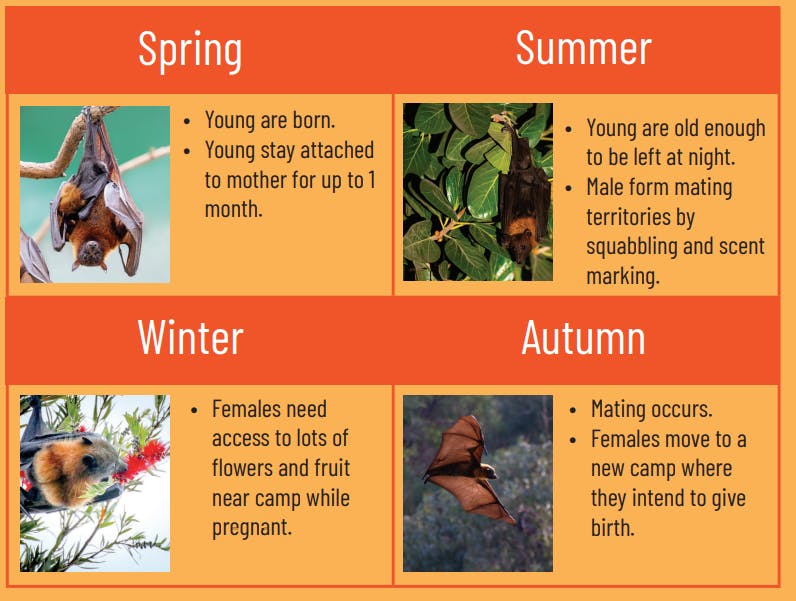Grey-headed flying-fox - Our local community page

We want to keep those most affected by Grey-headed flying-foxes (GHFF) updated.
Below and to the right of this page you can:
- Stay up to date with current information on what is happening at each site
- Ask us a question about anything grey-headed flying-fox related and we will get back to you
- Upload any photos you have to be shared in our photo gallery
- Know what is happening on key dates
As always, you can also refer to our website for general information Grey-headed flying-fox in Campbelltown.
What are Grey-headed flying-foxes?
Flying-foxes are nomadic mammals that travel across large areas of Australia, feeding on native blossoms and fruits, spreading seeds and pollinating native plants. The Grey-headed flying-fox (Pteropus poliocephalus) has a rusty reddish-coloured collar, grey head and unique hairy legs. It's the largest Australian bat with a wingspan up to 1 metre, can weigh up to 1 kilogram and is the most vulnerable flying-fox species because it competes with humans for prime coastal habitat along the south-east Queensland, NSW and Victorian coasts.
Why are they protected?
The Grey-headed flying-fox, like the koala and kangaroo, is a native species and is protected in Australia. It's also listed as Vulnerable to extinction in NSW and nationally and is protected by law because numbers have rapidly declined over a relatively short period of time. Unlike other pollinators like bees and birds, flying-foxes can transport pollen over vast distances and are also able to disperse larger seeds. This makes them vital to the health and regeneration of our native forests.
Understanding flying-foxes
While the noise made by flying-foxes can be unpleasant at times, vocalisation is an important part of how they communicate. For example, mothers use a special call to locate their babies. Smell is also important for communication between flying-foxes. Like koalas, male flying-foxes use scent to attract females. Mating behavior begins in January/February and continues through to April/May. Flying-fox droppings also play an important part in the dispersal of seeds for many native plant species.
Flying-fox camps
A flying-fox camp is a patch of trees that flying-foxes are found in during the day. Camps are generally located within 20 km of a regular food source and are commonly found in gullies, close to water, in vegetation with a dense canopy.
Being social animals, they congregate in these camps to roost, find a mate and feed their young. Flying-foxes can travel up to 50 km from their camps to feed at night, leaving at dusk and returning at dawn.
The numbers of flying-foxes at camps fluctuate with the food supply but they may host tens of thousands of animals at a time. The same animal may return to the same camp each year, but they may not. They can also move from one camp to another and back again over a few days. They also do not move as a uniform group with individual flying-foxes moving independently throughout their range.
Living near a flying-fox camp
Due to the loss of their native bushland habitat, flying-foxes are increasingly moving into urban areas. Living near these camps can sometimes be a problem, but there are ways to minimise the disturbance camps can cause.
- Don’t disturb flying-foxes. They are quietest when left alone.
- Planting low vegetation around your property can provide distance between your house and flying-foxes.
- Consider property modification options. For example, double-glazing of windows has been shown to reduce noise inside buildings.
- Where possible, keep vehicles under cover, and take washing off the clothesline before sunset to protect from droppings.
- To protect backyard fruit trees, use fine-meshed netting that you can’t poke a finger through, and keep it taut to prevent wildlife from getting entangled.
- Keep animal food and water dishes away from trees used by flying-foxes.
What we're doing to help
- Eligible residents living next to the Bingara Reserve Grey-headed flying-fox camp can apply for our Residential Assistance Program. We offer a one off payment of up to $1,000 to purchase goods or services to assist you to live alongside the GHFF camp.
- We've prepared the Macquarie Fields (Bingara Reserve) Grey-headed flying-fox Camp Management Plan (CMP) as a framework to manage issues associated with the camp while conserving flying-foxes and their habitat.
- We've implemented a restoration plan to restore the degraded habit, conserve the nationally important camp and provide additional roost habitat further away from residences to reduce conflict.



